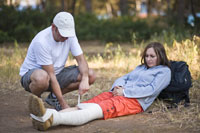- Details
- Written by: David
Joe Mulligan of the British Red Cross says that if we all made sure we understood the basics of emergency help, many of these incidents would be resolved more quickly, safely and with fewer long-term consequences. With a burn, for example, prompt action not only reduces the pain and the risk of infection, but also the chance of long-term scarring. Yet many people don’t learn first aid. ‘We don’t like to think an accident will happen to us; we always think it will be needed for a stranger – the man who collapses in the street, for example,’ says Mulligan.
Yet the reality is somewhat different: the vast amount of first aid you will ever need to use will be on a friend or member of the family.
Expert help may not be immediate. ‘People think that an ambulance will be imminent but they can take ten to fifteen minutes to arrive – and those first ten minutes are the most important in first aid. That is when you can really make a difference,’ says Mulligan.
And too many of us simply expect someone else to act. ‘We want you to be that person. If you use common sense, you will be okay. First aid has never been more important. At the Red Cross, our aim is now to get it taught in schools; it’s already beginning to appear as an option on the national curriculum. These are the adults of tomorrow – and this is a vital skill they need to learn.’
Victoria Lambert explains the best up-to-date advice on what to do in the most common first- aid scenarios and dispels some myths in the process...
How to treat accidents...
Do you put butter on a burn? Or should you run it under a cold tap? Is it very hot water you put on sea-urchin wound, or it cold? What about a snake bite? And exactly how do you remove a tick embedded in your child’s arm? Joe Milligan of the Red Cross provides some basic, easy-to-remember advice. But we all panic in an emergency, so read through the below. Or even better, go on a first-aid course…
Continued...
 In the outdoors
In the outdoors
Sprains/strains
A strain is a pull or twist of a muscle, while a sprain involves the complexities of a joint. For both, you need to know and remember the ‘RICE’ plan:
Rest. ‘People think you can walk off a strain – it’s a macho thing – but, in fact, you need to sit down and rest,’ says the Red Cross’s Mulligan.
Ice. You need to cool the affected area down to reduce the swelling and pain, and allow healing to begin as fast as possible. If you don’t have access to ice, stick something cold on the area. ‘You could stick your leg in a stream – or wrap a wet sock around it.’ Mulligan points out: ‘Some people get confused between using hot or cold, but it is always cold to start with. You may though, alternate cold and hot later, depending on medical advice.’
Comfortable support. ‘Get a sock and wrap it around the area, or use a couple of socks.’
Elevate. Keep it up for a while – preferably above the level of the heart. It will help reduce pain and swelling.
Blood loss
For minor wounds – scrapes, cuts and abrasions – the treatment is fairly obvious. ‘Clean the wound, using cold water, dry it and put on a plaster.’
But for more serious accidents, where a major blood vessel has been cut, direct pressure must be applied to the wound. ‘Elevate the limb above the level of the heart, and wrap in a clean T-shirt or towel. Don’t put on a tourniquet – we want to reduce the blood leaving the wound, not affect the supply to the whole limb.’
Frostbite
Get your casualty to place their hands in their armpits for warmth – then move the casualty to a warm place. Gently remove gloves, rings and anything constricting such as boots. Warm the affected part with your hands, in your lap or keep under their armpits – but don’t rub, as this may damage the tissues. Then place in warm water, dry carefully, and bandage lightly. Raise the limb to reduce swelling. Adults can take paracetamol, children can have the age-appropriate dose of paracetamol syrup (not aspirin).
Ticks
‘Use tweezers to grasp the head,’ says Mulligan, ‘and pull it slowly and gently, but firmly upwards. Don’t jerk or twist it, as that may leave body parts in and the poison from the tick will get further in.’
Continued...

At the campfire
Burns/scalds
One of the most common outdoor injuries is a burn or scald – whether it is from the campfire, or opening the radiator cap of an overheating car on the journey to your holiday.
‘When the outer layer of skin is damaged, you need to cool the area as soon as possible,’ says Mulligan. ‘All the data tells us that the best possible action is to place the burn under cold, running water for ten minutes. But if you don’t have access to a tap, use what you do have – a bottle of beer, or squash.’
Afterwards, you need to wrap a burn in clingfilm or even a clean sandwich bag. ‘This reduces the pain caused when the nerve endings in the skin are exposed to warm air. Plus, it keeps it clean and hydrated. This can help prevent scarring later on.’
Mulligan warns against automatically turning to special burn lotions or gels in first aid kits. ‘They’re fine if you have no alternative, but cold water is best.’
Wasp/bee stings
The first thing is to avoid tweezers. ‘They can squeeze the poison sac on the insect if it is still attached and result in more poison getting into the wound. Use your credit card or a clean fingernail to gently scrape the sting off the skin. Then raise the affected part, apply something cold, and get medical advice.’
Choking
Another problem at the campfire can be choking. The first thing to do is so obvious that many forget it. ‘Get them to try to cough the object up. If that doesn’t dislodge it, then deliver five sharp blows to the back with the heel of the hand between the shoulder blades. A slap is not enough force.’
If that hasn’t worked, Mulligan suggests you try the Heimlich manoeuvre. ‘Stand behind them with one hand beneath the sternum, and pull upwards and inwards five times. When you pull the diaphragm up, it squeezes the lungs a little, deflates them, and air is forced up the trachea, hitting the object that is stuck, and forcing it up and out. It’s very effective.’ He warns that afterwards the patient should always be checked over by a doctor, as this manoeuvre can damage the diaphragm. ‘People may worry about hurting the choking person – but it is much more important to get the item dislodged. Remember your priorities.’
Snake bite
Help the casualty to lie down, with head and shoulders raised, and keep them calm and still. If there is no pain, bandage the site of the bite, but don’t remove clothing from the area as this can speed up the absorption of the venom (you should note the time of the bite if you can, to tell the doctor later).
Apply another pressure bandage to extend from the bite as far up the leg as possible – and mark the site of the bite if you can. Immobilise the leg by securing it to the other leg. The aim is to stay as still as possible to keep the poison from spreading in the body. Then you should seek medical help.
Continued...
 At the beach
At the beach
Jellyfish
The pain from a jellyfish sting is caused by the venom in stinging cells, which attach themselves to the skin when it comes into contact with one of these sea organisms. Mulligan’s advice is to pour copious amounts of vinegar or seawater on to the area – which incapacitates the stinging cells – and to sit down and rest.
Heat stroke
Move the casualty to a cool place. Then help them to sit down, with support if possible. Wrap them in something cold and wet – a sheet is perfect, but a T-shirt will do if that’s all you have. Keep it wet by continually pouring water over it until the sufferer’s temperature falls to below 38 degrees (check under the tongue). If you don’t have a sheet or piece of cloth, fan them and sponge with cold water. When the temperature is back to normal, replace wet cloths with dry clothing. Keep an eye on the patient in case their temperature rises again – in which case, begin the cooling process again.
Embedded fishhook
Support the injured area and cut the fishing line as close to the hook as possible. If the barb is visible, you can use wire-cutters to cut it away, then carefully withdraw the hook back through the skin by its eye, before cleaning and dressing the wound. If you don’t have anything to cut the barb off, build up padding around the area until you can bandage over the top without pushing it in further. Then seek help.
Marine puncture wound
If you tread on a spiny sea creature such as a sea urchin, a spine can get stuck in your sole. Left in, it may become infected. But hot water breaks down sea venom, so help your casualty to sit down, and then immerse the affected part in water as hot as he can tolerate for 30 minutes. Then get the casualty to hospital so the spine can be removed.

 Do you know what to do in a medical emergency?
Do you know what to do in a medical emergency?

